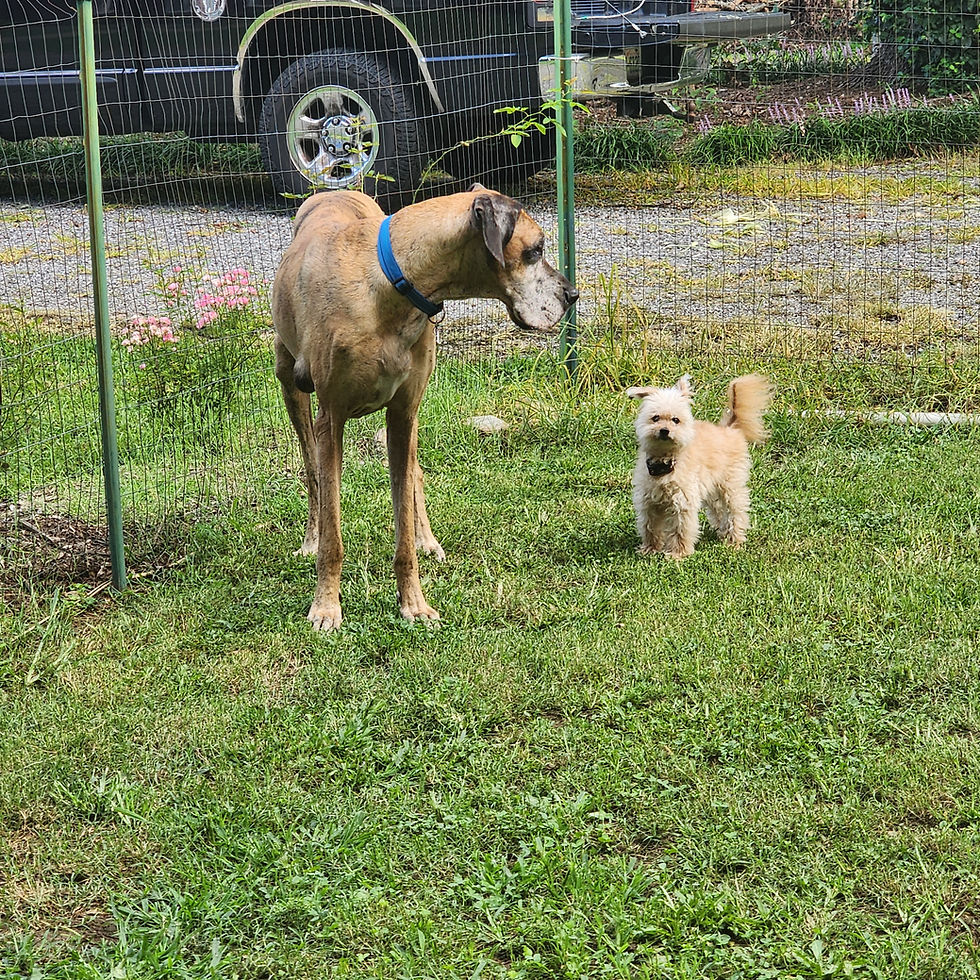Introducing the New Guy to the Pack: How We Integrate a New Dog into a Multi-Dog (and cat) Household
- Sep 5, 2024
- 4 min read

Introducing a new dog into a home with existing pets can be a delicate process, but we’ve been fortunate—our dogs have always seemed to adapt well to new additions. Maybe it’s because they’re naturally accepting, or perhaps I’ve become pretty good at letting them know, “This new dog or cat is important to me, so they’re going to be important to you too!” Either way, we rarely have issues when welcoming a new pet into our pack.
Before he arrived, I was told the little guy had been living with another dog and was used to being around cats, which was a relief. However, experience has taught me not to rely entirely on previous reports—every dog is different, and introductions can go smoothly or take some work.
First Impressions Matter: Setting Up the Introduction
When the new dog arrived, we took it slow. I put my current dogs in a separate room to let him explore our home comfortably without any pressure. This also gave my dogs the chance to hear and smell him before meeting him face-to-face. I chose to delay their initial meeting until the next day, as it was late, and he didn’t need any more stress.
Of my three resident dogs, Freya is the friendliest and most accepting of newcomers, so she met the new little guy first. Freya immediately took on the role of his caregiver, walking ahead of him and turning around to make sure he was following her. She became his guide around the house, and it was so sweet to see her showing him around. The second night he was on our bed and was crying a little and Freya immediately came to the side of the bed and asked get up too. I approved her request and she laid beside him and helped him settle.
The Slow and Steady Approach: Gradual Integration
The first morning after his arrival, I made sure Jasper and Zayla, my other dogs, could see me interacting with the new pup. I carried him around, showed him affection, and even fed him before letting the others out of their crates. This signaled to them that the new dog was important and that they should respect him.
We started with baby gate introductions. I’m lucky that my big dogs respect the gates even though they could easily knock them over or, in Jasper’s case, step over them. The new guy wasn’t particularly interested in meeting Jasper and Zayla right away, and Jasper didn’t seem overly curious either after a quick sniff. Over the next few days, we kept the dogs separated but allowed them to interact through the gates, giving them time to adjust without the pressure of direct contact.
During this period, I never left the new dog unattended. He was always with me, or he was safely crated or secured in a separate room. This ensured he didn’t feel overwhelmed or get bullied by the others, which can sometimes happen when dogs are left to their own devices too soon.
Second Official Meeting: Introducing Jasper
After a few days of baby gate interactions, I felt it was time to let the new guy meet Jasper. He instantly decided he LOVES Jasper. It really reminded me of the Looney Tunes cartoon with Spike and Chester. He followed him around, whining whenever Jasper didn’t stop to let him catch up. Jasper, on the other hand, seemed a bit freaked out by this intense new follower. At one point, Jasper gave him a low warning growl when the little guy got too close while he was lying down. Because the new dog has some vision and hearing impairments, he didn’t pick up on Jasper’s body language or growl. I stepped in right away and gently moved him.
Zayla Joins the Fun: Playful Acceptance
Zayla took a little longer to warm up to the new addition. At first, she was convinced he was a threat, but after about a week, she decided he wasn’t a threat and started trying to play with him. Zayla’s play style is unique—like many pitbulls, she does this adorable, bouncing “play dance,” which can be a bit intimidating for smaller dogs or all dogs for that matter. The little guy wasn’t sure what to make of her playful energy, but it’s been fun watching their interactions evolve.
Establishing the Pack Order: Feeding Together
Once the dogs were comfortable with each other, we started feeding them together. I feel it’s important to feed the new dog first, as this signals to the rest of the pack that the newcomer holds a special place. Over time, the dogs will naturally establish their own hierarchy, and while humans can’t control that entirely, we can help set the tone for respect during meals.
After two weeks, I felt confident enough to let all the dogs go outside together without constant supervision. None of them have given me any reason to worry, and I’m amazed at how seamlessly the little guy has integrated into the pack. He’s learning from the others—running out when they do, barking when they bark, and following along with the daily routine.
A New Member of the Family
Introducing a new dog into a household with other pets takes time, patience, and careful management, but the rewards are worth it. It seems he’s already found his place in our pack, and we’re all enjoying his unique personality. Even the cat has started to accept him, and that’s saying something!
If you’re considering bringing a new dog into your home, remember that most of the time, slow, careful introductions are key. Give your dogs time to adjust, supervise interactions, and let the pack work out their relationships naturally. With love and patience, you’ll soon have a happy home full of wagging tails.






Comments